Basic Motions (KihonDousa) of Sport Fukiya
Basic Motions (Kihon Dousa) of Sport Wellness Fukiya
Any sport has its basic motions (Kihon Dousa) and forms. If you do not learn them, you cannot have good results. The same is true of Sport Wellness Fukiya. It is not simple as just holding a blowpipe (Tsutsu) to your mouth and blowing. To fully enjoy the Sport Wellness Fukiya and maximize the good effect it has on your health, you need to master basic motions (Kihon Dousa) and practice them.
In the next section, we will explain the equipment used in Sport Wellness Fukiya and the basic motions (Kihon Dousa) made with them.
- Authorized Equipment -
The following is a list of the equipment used in Sport Wellness Fukiya. All equipment is authorized by Japan Sport Wellness Fukiya Association.
-
Blowpipe (Tsutsu)
- Length: 1200mm (47 inches), 1000mm (39 inches)
- Inner Diameter: 13mm (0.5 inch)
- Material: coated fiberglass plastic, carbon plastic, etc.
- ① on picture
-
Dart (Ya)
- Length: 200mm (7.8 inches)
- Material: plastic film and metal
- ② on picture
-
Target Sticker (Mato - seal)
- Scoring Numbers: 7, 5, 3, 1 points
- Material: paper, or urethane
- ③ on picture
-
Target (Mato)
- Size: 330 x 330mm (12.9 x 12.9inches)
- Material: urethane
- ④ on picture

You are required to use authorized equipment in practicing Sport Wellness Fukiya.
Basic Motions (Kihon Dousa) of Sport Wellness Fukiya
Learning Sport Wellness Fukiya Breathing (SportWellness Fukiya-shiki Kokyuuhou)
Sport Wellness Fukiya is designed to help people live a healthy life. It derives its ability from Sport Wellness Fukiya Breathing (SportWellness Fukiya-shiki Kokyuuhou) that is based on abdominal breathing.
The Basic Motions (Kihon Dousa) are so arranged as to make the most of Sport Wellness Fukiya Breathing (Sport Wellness Fukiya-shiki Kokyuuhou) and are ‘Correct Form’ (Kata), which constitute the basis of practicing Sport Wellness Fukiya. While training and learning the Basic Motions (Kihon Dousa), you will understand the importance of ‘Training of the Spirit and Technique’ that is set up as the eternal motto of Sport Wellness Fukiya.
The Basic motions (Kihon Dousa) are a series of motions that begin from and end with a bow (Rei). The smooth motions create beautiful forms, bring about deep breathing, heighten concentration, and give you vitality.
Through the Basic Motions (Kihonn Dousa) mentioned below, please learn the forms of Sport Wellness Fukiya and Sport Wellness Fukiya Breathing (Sport Wellness Fukiya-shiki Kokyuuhou). For the disabled, Certified Instructors make proper advice based on the grade of disability.
These are several basic motions (Kihon Dousa) of Sport Wellness Fukiya.
- Take a bow towards the target (Mato) - (Rei wo suru)
- Take a stance with your legs shoulder-width apart and insert a dart (Ya) - (Kamaeru)
- Breathe in through your nose as you raise your blowpipe (Tsutsu) - (Tsutsu wo ageru)-
- Breathe out through your mouth as you lower your blowpipe (Tsutsu) - (Iki wo haku)
- Look at the target (Mato) and taking a deep breath, aim at the target (Mato) - (Iki wo suu)
- Make one short strong blow - (Fuku)
- Calm your breathing while lowering your blowpipe (Tsutsu) - (Iki wo totonoeru)
- Take a bow towards the target (Mato) - (Rei wo suru)
Conducting these motions correctly with Sport Wellness Fukiya Breathing (Sport Wellness Fukiya-shiki Kokyuuhou) will heighten concentration and bring about a wonderful effect on your body and mind.
Explanation of Basic Motions (Kihon Dousa)
- Basic Motion 1 - Take a bow towards the target (Mato) - (Rei wo suru )-
-
In traditional Japanese martial arts and traditional Japanese arts, bowing must be done at the beginning and the end, which is the same for Sport Wellness Fukiya. You will realize the meaning of bowing in increasing depth as you practice and train your spirit and technique.
Stand right in front of the target (Mato). (See Picture 1)
-
Hold your blowpipe (Tsutsu) in between the thumb and forefinger of either right or left hand. (See Picture 2)
- Do not bend your elbow and do not touch your blowpipe (Tsutsu) onto the floor. (Keep about 5cm - 2inches between the tip of blowpipe (Tsutsu) and the floor).
- Look at the target (Mato).
-
Take a bow towards the target (Mato) - (Rei wo suru)
- When you bow, try to keep your upper part of the body straight. Bow about 30 degrees (look at about 3m forward on the floor).
- Keep blowpipe (Tsutsu) vertically and not to swing blowpipe (Tsutsu) backward. (See Picture 3)
- One round is done with five darts (Ya). Take a bow at the beginning and end of the round.
- One round is done with five darts (Ya). Take a bow at the beginning and end of the round.
- Bow (Rei) of the Sport Wellness Fukiya declares that he or she will start blowing pleasantly with thanks to the good health to himself or herself and persons around him or her.
From here, we explain as if you are the right-handed person. If you are the left-hander, please change to read “right” as “left” (or opposite).
-
Hold your blowpipe (Tsutsu) in between the thumb and forefinger of either right or left hand. (See Picture 2)
-
-
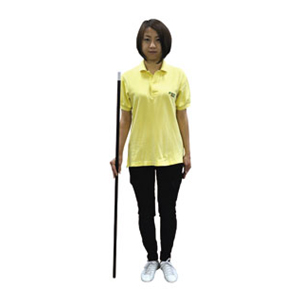
Picture 1
-
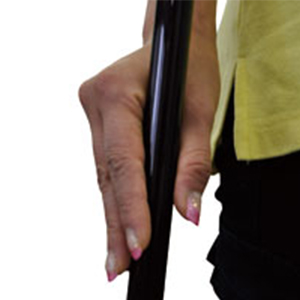
Picture 2
-

Picture 3
-
- Basic Motion 2 - Take a stance with your legs shoulder-width apart and insert a dart (Ya) - (Kamaeru)
-
After bowing, angle yourself to the line at 45 degrees. Stand with your feet shoulder-width apart. (See Picture 4)
-
Hold your blowpipe (Tsutsu) by your left hand at its center part, keeping it level with the floor, then, take out a dart (Ya) from your quiver and insert the dart (Ya) to the blowing point of blowpipe (Tsutsu) just where the dart (Ya) is hidden in the blowpipe (Tsutsu).
* Do not insert the dart (Ya) like throwing into the blowpipe (Tsutsu).
- Hold your blowpipe (Tsutsu) with both hands between your thumb and forefinger and keep it level with the floor. Place right hand five centimeters (2inches) away from the blowing edge. Your hands should be placed at shoulder width. (See Picture 5)
- Keep your blowpipe (Tsutsu) level with the floor and lower your hands with your fingers pointing to the floor.
-
Relax, and straighten your neck and back. This is “the basic posture for Take a stance (Kamaeru)”. (See Picture 6)
- Your eyes should look straight ahead of you at any time during “the basic posture for Take a stance (Kamaeru)”.
-
Hold your blowpipe (Tsutsu) by your left hand at its center part, keeping it level with the floor, then, take out a dart (Ya) from your quiver and insert the dart (Ya) to the blowing point of blowpipe (Tsutsu) just where the dart (Ya) is hidden in the blowpipe (Tsutsu).
-
-
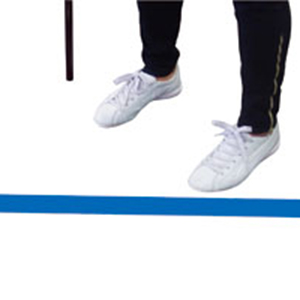
Picture 4
-
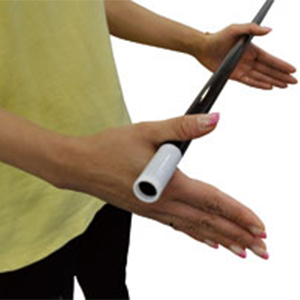
Picture 5
-
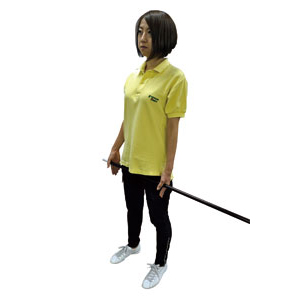
Picture 6
-
- Basic Motion 3 - Breathe in through your nose as you raise your blowpipe (Tsutsu)- (Tsutsu wo ageru)
-
From this step, “Sport Wellness Fukiya Breathing (Sport Wellness Fukiya-shiki Kokyuuhou)” begins.
-
Stretch your arms to the fingertips, and raise the blowpipe (Tsutsu) over your head like drawing a big circle with your fingertips. As you raise your arms, you need to inhale through your nose. When your arms reach your ears, or are raised as closely to your ears as possible, you should be at the point of your deepest inhale. (See Picture 7 - 9)
- This whole movement should take about three seconds.
- Try to look straight in front of you.
- By raising your blowpipe (Tsutsu), you can widen your chest and breathe in as much air as possible.
- At the same time, you can stretch your back muscle for your health.
-
Stretch your arms to the fingertips, and raise the blowpipe (Tsutsu) over your head like drawing a big circle with your fingertips. As you raise your arms, you need to inhale through your nose. When your arms reach your ears, or are raised as closely to your ears as possible, you should be at the point of your deepest inhale. (See Picture 7 - 9)
-
-
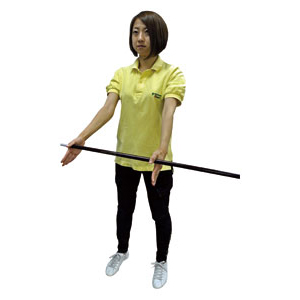
Picture 7
-
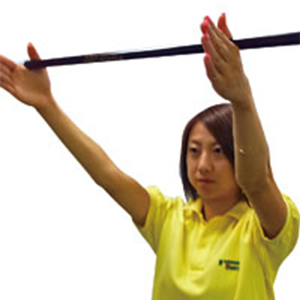
Picture 8
-

Picture 9
-
- Basic Motion 4 - Breathe out through your mouth as you lower your blowpipe (Tsutsu) - (Iki wo haku)
-
-
This is the most important stage of the Sport Wellness Fukiya Breathing (Sport Wellness Fukiya-shiki Kokyuuhou), where you concentrate and focus yourself. You may close your eyes or keep them half opened to enhance concentration.
- Stretch your arms, and exhale from your mouth, when you lower blowpipe (Tsutsu) slowly like drawing a big circle by the fingertips. Exhaling should take about nine seconds. (See Picture 10-12)
- To maximize the effect of the Sport Wellness Fukiya Breathing (Sport Wellness Fukiya-shiki Kokyuuhou), exhale from the mouth as slow and long and try to exhale all of your breath, while pulling in your abdominals.
- It may be easier to do this with your mouth shaped as when you whistle.
- When exhaling, do not lean forward and try not to make any sound.
- Try to exhale all of your breath.
-
After lower both arms (fingertips towards the floor, See Picture 12), face the target (Mato) immediately. Do not keep your face look straight ahead after lower the arms.
- Motions and breathing of the Sport Wellness Fukiya should be connected with smoothly. Otherwise, you may not get good result.
-
This is the most important stage of the Sport Wellness Fukiya Breathing (Sport Wellness Fukiya-shiki Kokyuuhou), where you concentrate and focus yourself. You may close your eyes or keep them half opened to enhance concentration.
-
-
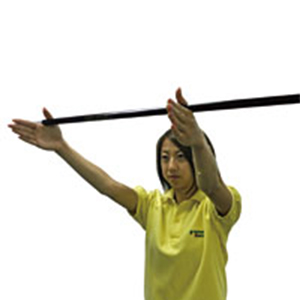
Picture 10
-
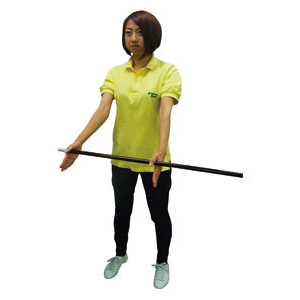
Picture 11
-
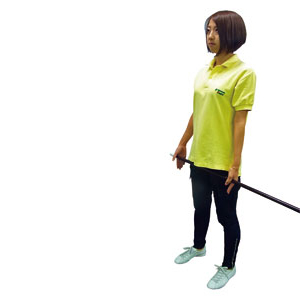
Picture 12
-
- Basic Motion 5 - Look at the target (Mato) and taking a deep breath, aim at the target (Mato) - (Iki wo suu)
-
-
Keeping your eyes to the target (Mato), raise your blowpipe (Tsutsu) near to your body, level with the floor. While raising your blowpipe (Tsutsu), inhale through your nose, aim with your blowpipe (Tsutsu) at the target (Mato), and hold it in your mouth. (See Picture 13)
- At the time when aiming is finished, inhaling should be finished.
- Keep your blowpipe (Tsutsu) level with the floor at all times.
- When you aim at the target (Mato), you need not to straighten your arms like standing at arm’s length.
-
Put your blowpipe (Tsutsu) into your mouth by about 3cm (1.2 inches) and hold it tightly.
- Try to avoid air leaking. It’s up to you how you keep the shape of your mouth and whether or not you bite your blowpipe (Tsutsu).
-
Place your right hand by your mouth or hold the blowpipe (Tsutsu) gently. Bend your left elbow slightly (angle of the elbow is about 120 degrees) and put your blowpipe (Tsutsu) onto the palm of your hand.
- Gripping the blowpipe (Tsutsu) may convey the motion of your body to the blowpipe (Tsutsu) and hinder your aiming.(See Picture 14, 15)
-
Your eyes should always be directed at the center of the target (Mato).
- The air is actually in your lungs, but you try to imagine that you are keeping the air in your abdomen, in particular around the part that is located beneath your belly button and that had traditionally been referred to as “Tanden” in Japan.
- Try not to aim with one eye. Aim with both eyes.
- It may be better to practice these motions without dart (Ya) at first.
-
Keeping your eyes to the target (Mato), raise your blowpipe (Tsutsu) near to your body, level with the floor. While raising your blowpipe (Tsutsu), inhale through your nose, aim with your blowpipe (Tsutsu) at the target (Mato), and hold it in your mouth. (See Picture 13)
-
-
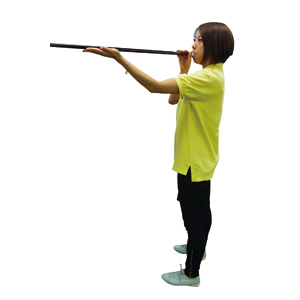
Picture 13
-
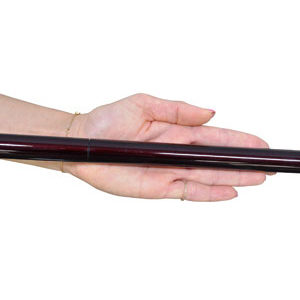
Picture 14
-

Picture 15
-
- Basic Motion 6 - Make one short strong blow - (Fuku) -
-
-
Look at the target (Mato) well. You may count 1, 2, and 3, and blow.
- It is important to cover the blowpipe (Tsutsu) by your lips tightly in order not to leak the air.
- This is the step where you concentrate yourself. Try not to think of anything.
- Blow out your air in one swift breath. Practice so you can feel your lower abdomen deflate the moment you release air.
- Always keep in mind what you want to improve in your performance when you blow. You will not improve if you practice without having a subject. You ought to challenge yourself with each blow. This way, every blow will leave a strong impression on you and you will accumulate significant experience even if you miss your mark.
-
Look at the target (Mato) well. You may count 1, 2, and 3, and blow.
- Basic Motion 7 - Calm your breathing while lowering your blowpipe (Tsutsu) - (Iki wo totonoeru) -
-
- Even after blowing, your mind should still be directed at the target (Mato) and calm down your breathing.
- This state is called “Zan-Shin” in Japanese martial arts, which means literally “remaining mind and body” and is the state of keeping alert or holding your guard after a successful stroke or shot. This gives calming effect to your mind and body.
- After blowing, keep looking at the target (Mato) and calm down your breath. Stretch out your both arms in front of you slowly. Keep both arms at about the level of your eyes. (See Picture 16)
-
When you finish this, direct your eyes in front of you. Lower your arms slowly with about 6 seconds as you breathe out calmly. Now you are back to “the basic posture for take a stance”.
- You are ready to insert the next dart (Ya). (See Picture 17)
- The thoracic and abdominal breathing used in Basic Motions 3 to 7 is called Sport Wellness Fukiya Breathing (Sport Wellness Fukiya-shiki Kokyuuhou).
-
-
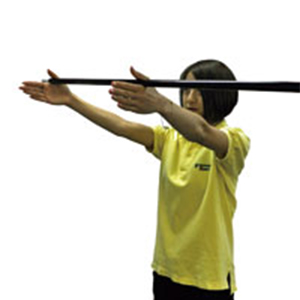
Picture 16
-
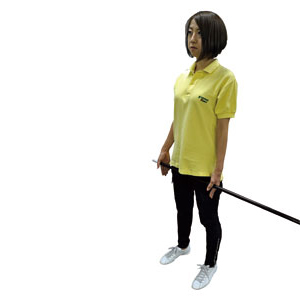
Picture 17
-
- Basic Motion 8 - Take a bow toward the target (Mato) - (Rei wo suru) -
-
-
After blowing 5 darts (Ya), stand straight facing the target (Mato). True up your heels, hold your blowpipe (Tsutsu) like you did at the beginning (See Picture 18 - 20) and take a bow towards the target (Mato).
- Lastly, take a bow (Rei) as Basic Motion “Take a bow (Rei wo suru)” ①-③
- After a bow (Rei), put your blowpipe (Tsutsu) on your Blowpipe (Tsutsu)-Stand, walk straightly to the target (Mato) and check your points.
- When some persons blow together at the competition, examination of the grades etc., step back approximately 1m after taking a bow (Rei) and wait quietly with your blowpipe (Tsutsu) on hand vertically.
-
After blowing 5 darts (Ya), stand straight facing the target (Mato). True up your heels, hold your blowpipe (Tsutsu) like you did at the beginning (See Picture 18 - 20) and take a bow towards the target (Mato).
-
-

Picture 18
-

Picture 19
-

Picture 20
-
Things to do after blowing
Now we will explain what you should do after the blowing. The equipment used is considered the authorized one by Japan Sport Wellness Fukiya Association.
-
1〉Pulling out the darts (Ya) you blew (Yanuki) and Point Rating
- - After blowing five darts (Ya) and taking a bow (Rei), come to the target (Mato) for point rating.
- - For beginners, just hitting the target (Mato) is a great achievement.
- - White part at the center of the target (Mato) is 7 points (black small circle at the real center is also 7points). Red part is 5 points. Outer white part is 3 points, and outer black part is 1 point. When darts (Ya) hit the dividing line, count as a higher point.
- - Refer to the following chapter “Dan-Kyu-I Ranking System” for the relationship between the points and the distance to the target (Mato).
- - After point rating, pull out your darts (Ya) from the target (Mato) using your Yanuki stick. (See Picture A)
- - Hold the leading end of the dart (Ya) and slowly pull it out by using the other hand. If you do not have a Yanuki stick, you can pull the dart (Ya) out with your hands.
- - Put your darts (Ya) back in your quiver.
-
2〉Cleaning your blowpipe (Tsutsu)
- - After blowing several darts (Ya), the inside of your blowpipe (Tsutsu) gets wet from the moisture of your breath. In that case, a dart (Ya) may stick to the inside of your blowpipe (Tsutsu) and may not fly properly.
- - To avoid this, use a blowpipe (Tsutsu) cleaner. (See Picture B)
- - Wipe the inside of your blowpipe (Tsutsu) with a blowpipe (Tsutsu) cleaner after every round. Exchange cloth or tissue regularly for sanitation.
-
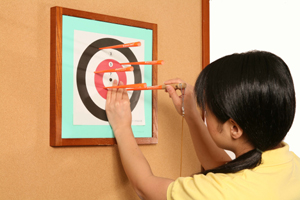
Picture A
-
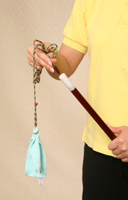
Picture B
-
3〉Confirmation of your darts (Ya)
- - Make a habit of checking the condition of your darts (Ya) after cleaning up your blowpipe (Tsutsu).
- - Darts (Ya) may become deformed, and the nail on the head may come off with use. Darts (Ya) in poor conditions will not fly properly.
- - You may be able to repair them using glue. But we recommend that you ask specialists for help. Deformed darts (Ya) may be fixed by inserting a Yanuki stick into the dart (Ya).
- - It is important that the internal diameter of your blowpipe (Tsutsu) matches the diameter of the dart (Ya). To make sure the size is right, hold the blowpipe (Tsutsu) vertically and drop a dart (Ya) into it. If the dart (Ya) falls down through the blowpipe (Tsutsu) with a small friction sound, the size is appropriate. To modify the diameter of a dart (Ya), you may trim the end of the dart (Ya) a little by little.
Everything written above is the principle and recommended methods that Certified Instructors teach to Sport Wellness Fukiya beginners. The content is subject to change after the regular review of the extension and diffusion committee. Any change will be informed in the bulletin of Japan Sport Wellness Fukiya Association.
